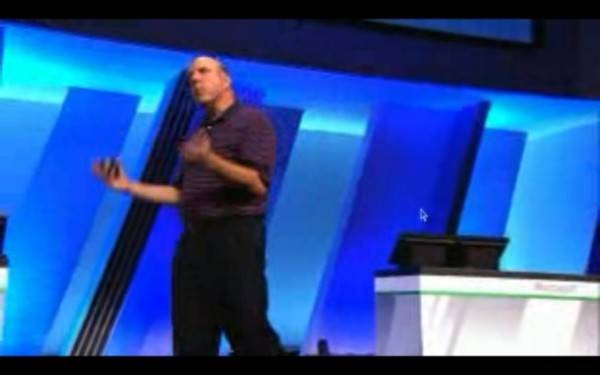
In a closing word to developers at the Build 2011 conference in Anaheim late this morning, a noticeably slimmer Microsoft CEO Steve Ballmer expressed a more subdued level of enthusiasm than we’ve seen from him in the past – still upbeat, but more measured, perhaps more quietly confident. In this more enlightened state, he expressed a degree of candidness about the initial reaction to the Windows 8 developer preview.
“It’s clear we have a long way to go, still, with Windows 8. We’ve been gratified, certainly, by the reactions and the interests,” the CEO began his talk to developers this morning. He noted about 500,000 downloads of the Developer Preview build, released yesterday, have been registered thus far.
Ballmer acknowledged that Microsoft’s shift of its applications model is in the very early stages, implying that while the company is being re-imagined as part of its re-imagining of Windows, a full scale rethinking of the platform may be somewhat down the road.
“I was reminded in a customer meeting the other day, while everybody’s willing to say, ‘We’re all in the cloud! It’s all about the cloud!’ the speed at which people really think that applications will move to these continuous services, [will] get delivered to these connected devices, whether it’s through the browser or through more application-oriented forms like Metro-style apps, we are still very much in the early days of that phenomenon.”
Microsoft officials and executives speaking with RWW yesterday emphasized with double-underscores that the development preview stage presently has no discrete, or even private, timeframe. It might have one at the time the public beta process officially begins, but even this preview should not be categorized as a “beta.” Indeed, we’re beginning to see indications that much of the usage model we’ve been introduced to this week may be subject to change.
“We’re 100% committed to supporting these platforms and the cloud with our applications,” said the CEO, “and yet we feel like we’ve just begun to scratch the surface.”
ARM-based tablets and Windows-based tablets will both be geared for Windows 8. However, officials do appear to be backing away from their initial promise, made at the All Things D conference in June, that existing Windows applications (“Desktop apps”) will run on the Windows 8 desktop without incident. That might be way too big a promise to have made. The WinRT platform is being devised for cross-platform deployment, but only for apps that take advantage of the new Metro style, and are installed as tiles on the new Start Screen.
Thus Ballmer made use of an appropriate qualifier to describe the new relationship between Windows 8 and its new hardware platform.
“X86 and ARM will both be important chip families as we move forward, and I think that’s important for me to stress for this audience,” Ballmer said. “It’s not going to be Intel or ARM; it’s going to be Intel and ARM for various usage scenarios and the like. PCs, tablet form factors, phones. New UI and input paradigms like the connected paradigm that we brought to the Xbox platform. New highly virtualized servers and really, over time, completely reconfigured data centers for the relationship between storage, compute, and networking pivots dramatically from what it is today.”

Ballmer spotlighted the work being done to better integrate client-side applications with cloud services. But even then, and despite a few specific examples, he stuck to ethereal allusions as to the depths of the project.
“The list of things that we’re doing in Azure and Windows Live, the list of new services to support exciting application development, it is a very, very long list that will come at a very, very fast cadence,” he said. “We’re taking a look at every one of our cloud applications and asking, what aspects of this application might also be interesting to developers? In Office 365, how do we make SharePoint a general-purpose platform that you can extend through Azure? How do we take Bing data and put it into a form where it is an extensible element that can be used by developers in your own application? What else is there in Bing for which we should provide extensibility? And the list goes on and on.”





















